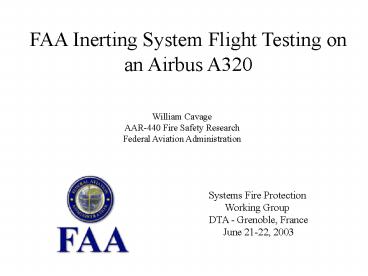Ground Based Fuel Tank Inerting - PowerPoint PPT Presentation
Title:
Ground Based Fuel Tank Inerting
Description:
Uses Air Separation Modules based on HFM technology. Excepts hot air from aircraft bleed system ... overboard, H/X cooling air deposited in cargo bay near ... – PowerPoint PPT presentation
Number of Views:141
Avg rating:3.0/5.0
Title: Ground Based Fuel Tank Inerting
1
FAA Inerting System Flight Testing on an Airbus
A320
William CavageAAR-440 Fire Safety
ResearchFederal Aviation Administration
Systems Fire Protection Working Group DTA -
Grenoble, France June 21-22, 2003
2
Outline
- Goals and Objectives
- OBIGGs
- Instrumentation
- System
- Center Wing Tank
- OBOAS
- Additional Parameters
- Analysis
- Data
- System Performance
- Fuel Tank Inerting
- Summary
3
Testing Goals and Objectives
- Validate the simplified inerting concept and
develop/expand upon existing system performance
models - Examine system sizing requirements
- Validate in flight inert gas distribution
assumptions - Examine potential operational effects on the
ability of a system to maintain inert conditions
in a fuel tank
4
OBIGGS - System Architecture
- Uses Air Separation Modules based on HFM
technology - Excepts hot air from aircraft bleed system
- Cools, filters, and conditions air
- Air is separated by ASMs and NEA is plumbed to
output valves to control flow - OEA is dumped overboard, H/X cooling air
deposited in cargo bay near outflow valve - System configured to operate in high and low
flow modes - Prototype system controlled by control box in
cabin that is connected to system with cable - Install system in test aircraft cargo bay for
simplicity sake
5
FAA OBIGGs Installation Drawing
6
FAA OBIGGs Installation Drawing
7
FAA OBIGGS Installation
8
Instrumentation and Data Acquisition
- Various thermocouples and pressure transducers
used to evaluate system performance - OBIGGS system flow meter and 2-channel oxygen
analyzer for NEA and OEA analysis - Eight sample locations within the Center-Wing
Tank (CWT) - FAA Onboard Oxygen Analysis System (OBOAS)
utilized - Aircraft parameters measured
- Airbus data acquisition system utilized
- Full-up flight worthy DAS
9
System Instrumentation Diagram
Spare O2
Temperature
Static Pressure
Static Pressure
Temperature
NEA O2
Static Pressure
Temperature
OEA O2
Temperature
Static Pressure
Temperature
Temperature (FAA Reader)
Penetration Hole
10
Flow Meter
11
CWT Instrumentation
Vent Location
NEA Deposit
12
OBOAS Mounted in A320 Test Aircraft
13
Test Plan
- Operated system in two flow mode for a series of
tests with a 39,000 ft cruise altitude and a high
rate of descent (4k ft/min) - Descended to 3,000 feet for operational purposes
- Nine total tests, 6 relative to FAA testing goals
and objectives - Used OBIGGS in both a single ASM configuration
and a 2-membrane configuration to evaluate sizing
requirements - Testing proved the FAA system concept, acquired
system sizing data, and examined the effects of
several operational conditions - Studied effect of fuel on an inert ullage
- Studied effect of the high flow mode on the inert
ullage - Studied effect of bleed air on the membrane
performance
14
Table of Airbus Flight Tests
15
Data Analysis
- Calculation of bleed air consumed
With NEA Oxygen Concentration
OEA Oxygen Concentration
- Model of Ullage gas Oxygen Concentration
Mass of oxygen in tank at time t
Mass flow rate of inerting gas (in terms of
t) IGOF Fraction of oxygen in inerting
gas ?? Change in Ullage Density due to
Altitude Change VTank Volume of Tank
Ullage mTank Mass of Gas in Tank mair
Mass of air entering tank
16
Results - System Performance
- System performed as expected with predictable ASM
dynamic charactaristics - Easily predicted with static measurements
- 2-membrane system configuration gave
approximately double the NEA - Less at altitude probably due to OEA back
pressure - Bleed air consumption greater then expected
- Aircraft bleed air pressures were higher then
expected at altitude - ASM degraded during the ground and flight testing
( 100 hours) giving about a 14 reduction in
productivity - Not much more then normal expected break-in of
ASM
17
System Performance Data
18
One vs. Two ASM Performance Data
19
Bleedair Consumption Data
20
Results - Tank Inerting
- CWT inerting accomplished easily
- No stratification observed, ullage acted in a
very homogenous manner - Two ASM inerting gave very little benefit
compared to a single ASM - Different system tuning could change that
- High flow mode effective at helping maintain a
low resulting ullage oxygen concentration during
descent - Fuel load had very little effect on measured
ullage oxygen concentrations for both static and
consumed fuel loads - Simple model effective at predicting resulting
ullage oxygen concentration given a system
performance and mission profile
21
CWT Inerting Oxygen Concentration Data
22
One vs. Two ASM Tank Inerting Data
23
High Flow Mode Benefit Tank Inerting Data
24
Effects of Fuel Tank Inerting Data
25
System Performance Data
26
Summary
- FAA simplified OBIGGS concept validated
- System performance predictable
- Bleed air consumption significant
- ASM performance degradation needs to be studied
further - Fuel tank inerting
- Inert gas distribution accomplished easily
- System tuning needs to be studied further to say
true benefit of 2 ASMs versus 1 - Two flow mode beneficial
- Fuel load effected resulting ullage oxygen
concentration very little - Ullage inerting easily modeled given a system
performance































